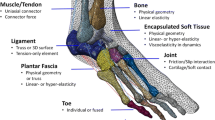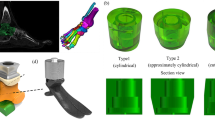Abstract
Prosthetic feet have generally been designed experimentally by adopting a trial-and-error technique. The objective of this research is to introduce a novel numerical approach for the a priori evaluation of the roll-over shape (ROS) of a prosthetic foot for application in its systematic design and development. The ROS was achieved numerically by employing a non-linear finite element model incorporating the augmented Lagrangian and multi-point constraint contact formulations, a hyperelastic material model and a higher-order strain definition. The Ottobock Solid Ankle Cushion Heel (SACH) foot was chosen to experimentally validate the numerical model. The geometry of the foot was evaluated from optical scans, and the material properties were obtained from uniaxial tensile, shear and volumetric compression tests. A new setup was designed for an improved experimental determination of the ROS, with the inclusion of an extended moment arm and variable loading. Error analysis of the radius of curvature of the ROS between the numerical and experimental results showed the percentage error to be 7.52%, thereby establishing the validity of the model. A numerical design model of this kind can be utilised to vary the input design parameters to arrive at a prosthetic foot with specified performance characteristics effectively and economically.

Graphical abstract










Similar content being viewed by others
References
Nolan L, Wit A, Dudziñski K, Lees A, Lake M, Wychowañski M (2003) Adjustments in gait symmetry with walking speed in trans-femoral and trans-tibial amputees. Gait Posture 17:142–151
Perry J, Boyd LA, Rao SS, Mulroy SJ (1997) Prosthetic weight acceptance mechanics in transtibial amputees wearing the Single Axis, Seattle Lite, and Flex Foot. IEEE Trans Rehabil Eng 5:283–289
Fey NP, Silverman AK, Neptune RR (2010) The influence of increasing steady-state walking speed on muscle activity in below-knee amputees. J Electromyogr Kinesiol 20:155–161
Isakov E, Keren O, Benjuya N (2000) Trans-tibial amputee gait: time-distance parameters and EMG activity. Prosthetics Orthot Int 24:216–220
Knox EH (1996) The role of prosthetic feet in walking. PhD Thesis, Northwestern University
Snyder RD, Powers CM, Fontaine C, Perry J (1995) The effect of five prosthetic feet on the gait and loading of the sound limb in dysvascular below-knee amputees. J Rehabil Res Dev 32:309–315
Van Jaarsveld HWL, Grootenboer HJ, Koopman HFJM, de Vries J (1990) Stiffness and hysteresis properties of some prosthetic feet. Prosthetics Orthot Int 14:117–124
Geil MD (2002) An iterative method for viscoelastic modeling of prosthetic feet. J Biomech 35:1405–1410
Postema K, Hermens HJ, De Vries J et al (1997) Energy storage and release of prosthetic feet Part 1: biomechanical analysis related to user benefits. Prosthetics Orthot Int 21:17–27
Lehmann JF, Price R, Boswell-Bessette S, Dralle A, Questad K (1993) Comprehensive analysis of dynamic elastic response feet: Seattle ankle/lite foot versus SACH foot. Arch Phys Med Rehabil 74:853–861
Toh SL, Goh JCH, Tan PH, Tay TE (1993) Fatigue testing of energy storing prosthetic feet. Prosthetics Orthot Int 17:180–188
Curtze C, Hof AL, van Keeken HG, Halbertsma JPK, Postema K, Otten B (2009) Comparative roll-over analysis of prosthetic feet. J Biomech 42:1746–1753
Perry J (1992) Gait analysis: normal and pathological function. McGraw-Hill, New York
Morawski J, Wojcieszak I (1978) Miniwalker – a resonant model of human locomotion. In: Proceedings of the 6th Int. Congress of Biomechanics. University Park Press, Baltimore, pp 445–451
Ju M-S (1986) The modeling and simulation of constrained dynamical systems-with application to human gait. PhD Thesis, Case Western Reserve University
Koopman HFJM (1989) The three-dimensional analysis and prediction of human walking. PhD Thesis, University of Twente, The Netherlands
Hansen AH, Childress DS, Knox EH (2004) Roll-over shapes of human locomotor systems: effects of walking speed. Clin Biomech 19:407–414
Hansen AH, Childress DS, Miff SC (2004) Roll-over characteristics of human walking on inclined surfaces. Hum Mov Sci 23:807–821
Hansen AH, Childress DS (2005) Effects of adding weight to the torso on roll-over characteristics of walking. J Rehabil Res Dev 42:381–390
Hansen AH, Childress DS (2004) Effects of shoe heel height on biologic rollover characteristics during walking. J Rehabil Res Dev 41:547–554
Hansen AH, Childress DS, Knox EH (2000) Prosthetic foot roll-over shapes with implications for alignment of trans-tibial prostheses. Prosthetics Orthot Int 24:205–215
Stein JL, Hu S (1988) No title. In: DSC 7, ASME WAM. New York
Saunders MM, Schwentker EP, Kay DB, Bennett G, Jacobs CR, Verstraete MC, Njus GO (2003) Finite element analysis as a tool for parametric prosthetic foot design and evaluation. Technique development in the solid ankle cushioned heel (SACH) foot. Comput Methods Biomech Biomed Engin 6:75–87
Allard P, Trudeau F, Prince F, Dansereau J, Labelle H, Duhaime M (1995) Modelling and gait evaluation of asymmetrical-keel foot prosthesis. Med Biol Eng Comput 33:2–7
Bonnet X, Pillet H, Fodé P, et al (2012) Finite element modelling of an energy-storing prosthetic foot during the stance phase of transtibial amputee gait. In: proceedings of the institution of mechanical engineers, part H: journal of engineering in medicine. 70–5
Omasta M, Paloušek D, Návrat T, Rosický J (2012) Finite element analysis for the evaluation of the structural behaviour, of a prosthesis for trans-tibial amputees. Med Eng Phys 34:38–45
Jang TS, Lee JJ, Lee DH, Yoon YS (2001) Systematic methodology for the design of a flexible keel for energy-storing prosthetic feet. Med Biol Eng Comput 39:56–64
Winter DA (1990) Biomechanics and motor control of human movement. John Wiley & Sons, New York
Klodd E, Hansen A, Fatone S, Edwards M (2010) Effects of prosthetic foot forefoot flexibility on gait of unilateral transtibial prosthesis users. J Rehabil Res Dev 47:899–910
Wriggers P (2006) Computational contact mechanics. Springer, Heidelberg
Hansen AH, Sam M, Childress DS (2004) The effective foot length ratio: a potential tool for characterization and evaluation of prosthetic feet. J Prosthetics Orthot 16:41–45
Anitescu C, Atroshchenko E, Alajlan N, Rabczuk T (2019) Artificial neural network methods for the solution of second order boundary value problems. Comput Mater Contin 59:345–359
Hansen AH (2002) Roll-over characteristics of human walking with applications for artificial limbs. PhD Thesis, Northwestern University
Author information
Authors and Affiliations
Corresponding author
Ethics declarations
Conflict of interest
The authors declare that they have no conflict of interest.
Additional information
Publisher’s note
Springer Nature remains neutral with regard to jurisdictional claims in published maps and institutional affiliations.
Rights and permissions
About this article
Cite this article
Balaramakrishnan, T.M., Natarajan, S. & Srinivasan, S. Roll-over shape of a prosthetic foot: a finite element evaluation and experimental validation. Med Biol Eng Comput 58, 2259–2270 (2020). https://doi.org/10.1007/s11517-020-02214-9
Received:
Accepted:
Published:
Issue Date:
DOI: https://doi.org/10.1007/s11517-020-02214-9




